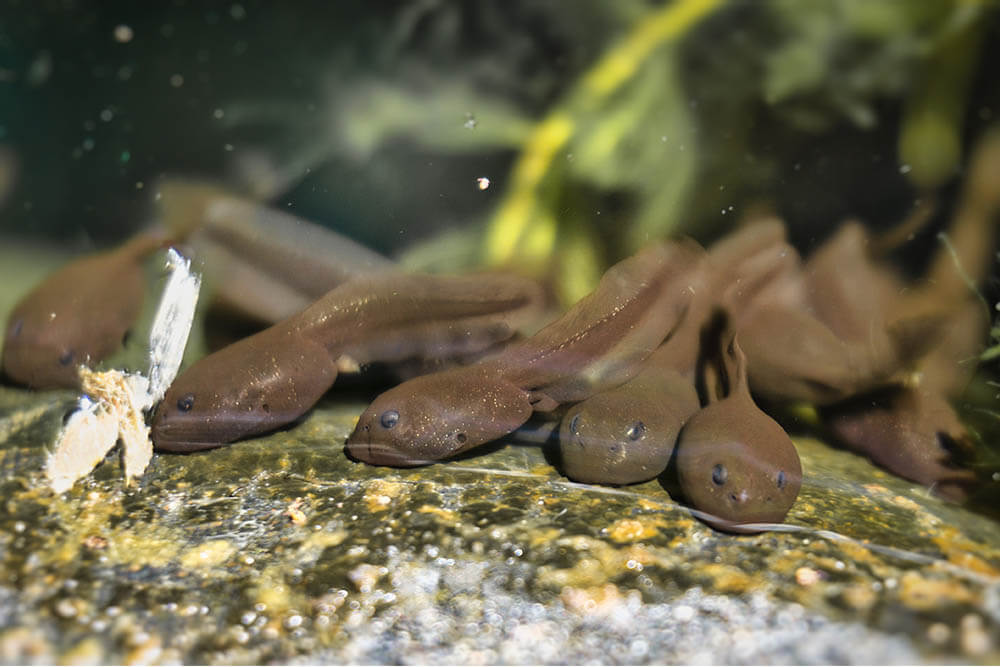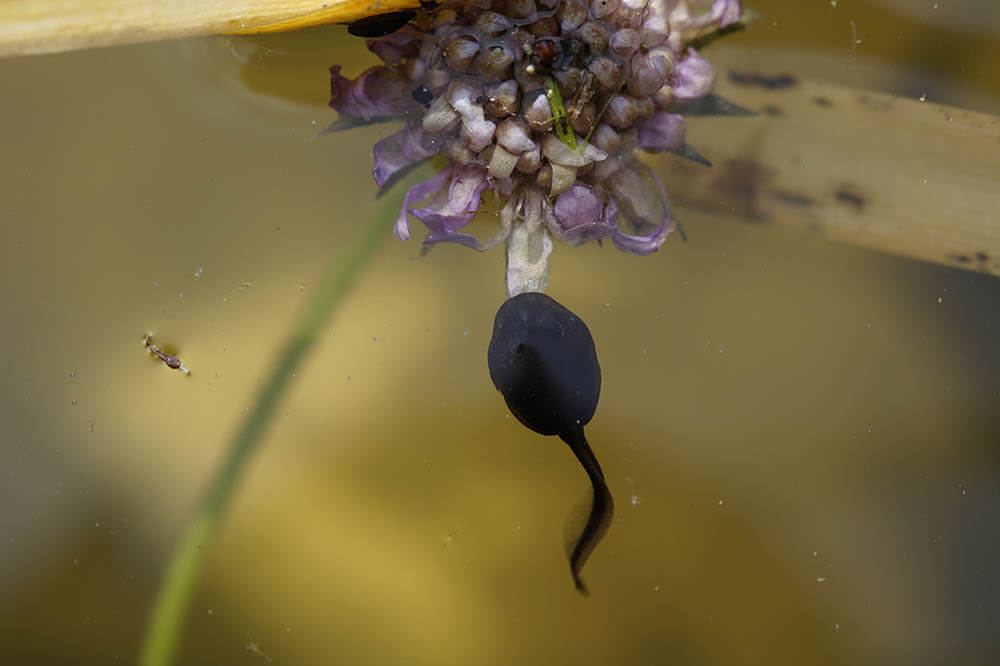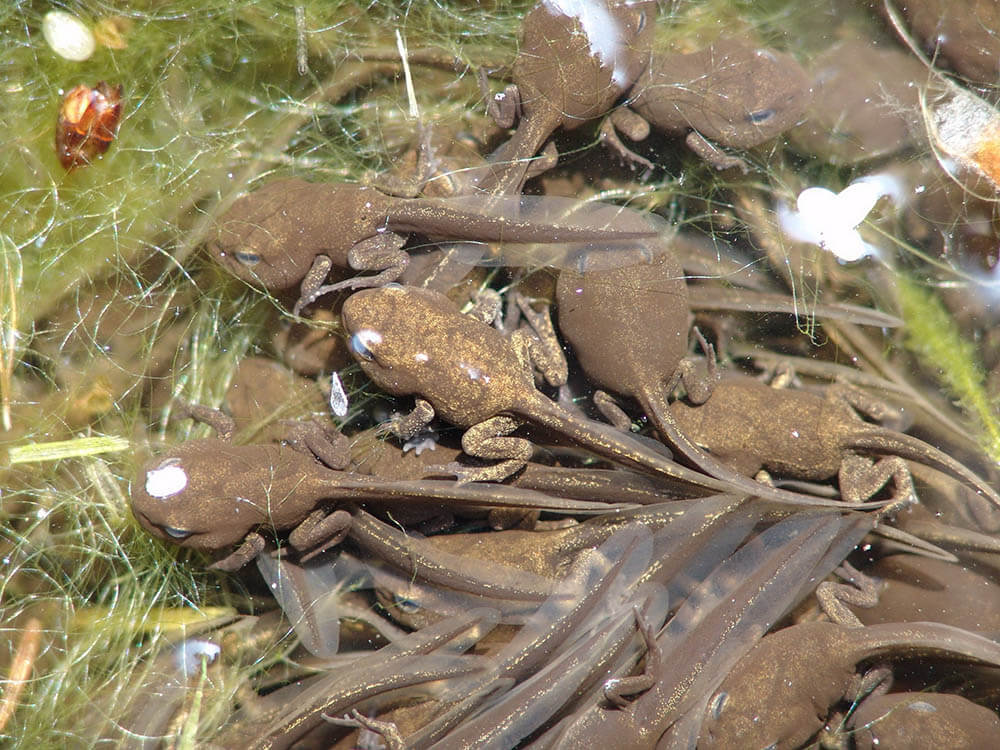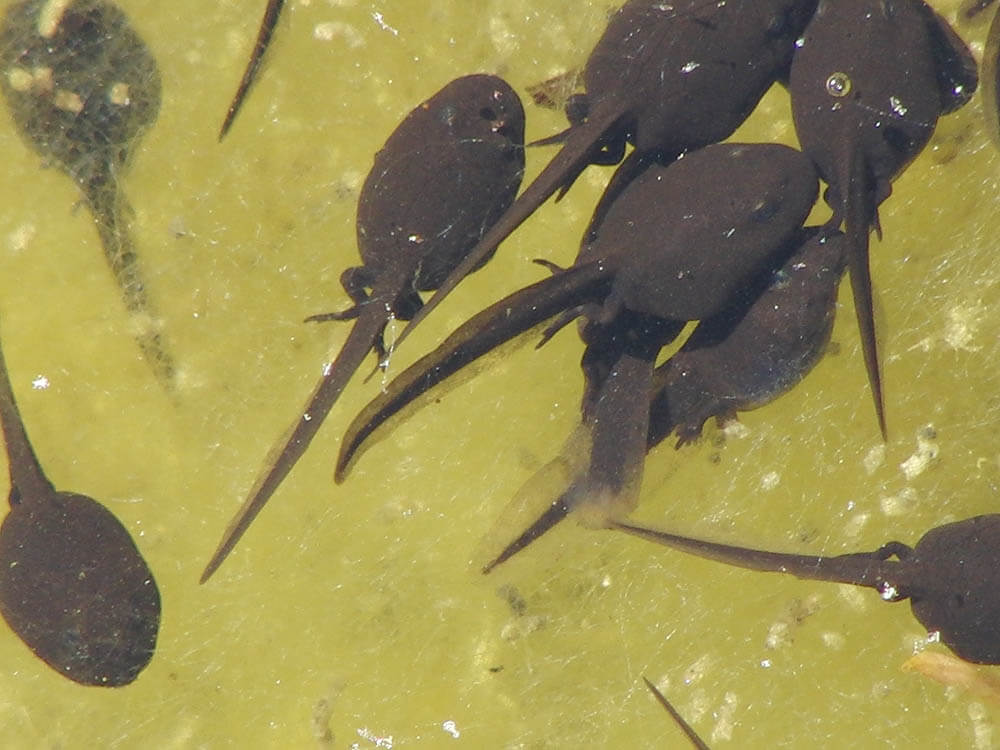Tadpoles are such cute little critters it’s no surprise so many animal enthusiasts are enamored with them. But have you ever wondered what these creatures eat that allows them to transform into equally cute frogs or toads?
Remember, tadpoles are babies, which means that they can’t consume the wrong foods as it can have disastrous results on their tiny, delicate bodies. Knowing what these creatures feed on is even more important if you own a pet tadpole, as it’s your responsibility to ensure it not only survives this fragile stage of life but also grows up healthy and strong.
If you’re one such tadpole keeper, then you’re in luck, because the tadpole diet is exactly what we’ll be discussing today. Before we do that, however, let’s get to know these creatures a little better!

What Are Tadpoles?
Also known as a polliwog, the tadpole is the aquatic larval form of toads and frogs.
The tadpole features a round head with a tiny mouth, and a short oval body with a broad tail and internal gills covered by a lid-like structure known as an operculum.
The tadpole undergoes a visually extraordinary metamorphosis as it grows; in addition to swelling in size, it also sprouts legs, loses its tail, and experiences various other changes before finally assuming the form of a typical frog or toad. This transformation is one of the various reasons why tadpoles are such fascinating creatures.
Tadpoles begin life as purely aquatic creatures. Thanks to the aforementioned metamorphosis that occurs as they grow older, however, they eventually emerge onto land as young toadlets or froglets.
Depending on the species of frog or toad, the tadpole stage of life can range from two weeks to three years. For most species, however, this stage lasts between one and three months.

What Do Tadpoles in the Wild Eat?
Upon hatching, the first thing a tadpole consumes is the yolk that remains from its own egg. This yolk is rich in nutrients that this creature needs for healthy growth.
Once it’s stuffed itself with egg yolk, the tadpole then begins its existence as a herbivore, which means it only eats plant matter. In particular, this critter enjoys soft plant matter such as algae, duckweed, lily pads, moss, and the roots or leaves of aquatic plants. It feeds on such foods multiple times daily to receive the appropriate amount of nutrition it needs to develop normally.
During this time, the tadpole is unable to leave the water – which doesn’t lead to drowning as it has gills. To defend itself from predators that are only too happy to catch something as defenseless as a baby frog or toad, the tadpole spends most of its young life hiding among aquatic plants, which also serve as a nutritional source for it.
As the tadpole grows older, however, its diet becomes more complex to include meat, thus making it omnivorous. Typically, the juvenile leaves its hiding place to hunt small redworms, mosquito larvae, or any other creatures tiny enough to fit in its mouth. In the case of severe food shortage, the tadpole may even devour its fellow polliwogs. Yikes!
Though tadpoles aren’t picky eaters and will consume whatever they have easy access to, they generally prefer duckweed or algae over meat. In fact, they’ll only look for prey when edible aquatic vegetation is scarce.
The tadpole only becomes almost fully carnivorous when it finally transforms into a frog or toad.
With all that in mind, let’s look at a more detailed list of the foods tadpoles typically eat.
The wild tadpole diet
In their natural habitat, wild tadpoles feed on the following foods:
- Algae
- Animal carcasses
- Bacteria
- Detritus
- Duckweed
- Fairy shrimp
- Fish eggs
- Frog eggs
- Moss
- Mosquito larvae
- Protozoa
- Redworms
- Tadpoles
- Water striders
One of the reasons why younger tadpoles feed on vegetation only is because they have long intestines that especially evolved to digest plant matter. As they grow older, however, these intestines shorten, prompting them to eat anything that they can swallow, from small insects to leaves.
What tadpoles specifically eat depends on the body of water they hatched in. For example, if a tadpole lives in a pond, it’ll have access to fewer varieties of food. In general, the diet of a pond tadpole is largely composed of mosquito larvae and algae. If that pond has plenty of fish, it’ll also consume fish eggs, frog eggs, and fish carcasses.
Sometimes, pond tadpoles will even ingest one another. According to studies, limited food can encourage cannibalism among tadpoles, and as ponds usually have a low supply of food for young, growing amphibians, pond tadpoles are more likely to resort to cannibalism than tadpoles living elsewhere.

What Do Tadpoles in Captivity Eat?
Because you can control what a pet tadpole eats, you can ensure it enjoys a nutritional, well-balanced diet most appropriate for young, growing frogs.
We recommend feeding your pet a mostly herbivorous diet. Foods such as boiled cabbage, lettuce, and other leafy greens are particularly good for it, as these veggies contain protein (a nutrient that’s essential for the body’s healthy growth) and calcium (a mineral that’s crucial for the development and maintenance of strong, healthy bones).
Here’s a more detailed list of the foods you can feed your tiny pet.
- Algae
- Algae wafers/flakes
- Aphids
- Baby spinach
- Bloodworms
- Brine shrimp flakes
- Broccoli
- Cabbage
- Commercial tadpole food
- Crickets
- Cucumbers
- Egg yolks
- Fish flakes
- Fruit flies
- Green peas
- Insect larvae
- Lettuce
- Mealworms
- Shrimp flakes
- Zucchini
Below are some tips on how to feed your tadpole properly!
Consider your tadpole’s age
Your tadpole’s age will determine what kind of food is right for it.
A newly hatched tadpole has limited options when it comes to what it can consume. You should therefore let it feed on the yolk of its egg for the first few days of its life. It’ll also enjoy the algae in its tank.
A tadpole that’s 1 to 2 weeks old can be fed algae as well as other types of soft plant matter, including boiled, finely chopped greens such as broccoli and lettuce.
Once a tadpole is 2 to 4 weeks old, you can start feeding it meat such as insects and larvae.
If you’re going to feed your pet some tadpole food, check its label to see if it’s appropriate for its age. If your pet is no older than 6 weeks, for example, you should only offer it tadpole food that was made for tadpoles no older than 6 weeks old. If your tadpole is older, you should give it late-stage tadpole food, which usually includes more animal matter and is thus typically higher in protein.
Also, don’t feed a tadpole that’s less than 6 weeks old any bloodworms. These creatures are most suitable for older tadpoles.
Choose nutritious foods for your tadpole
Always choose the food that’s best for your pet. This means sticking to a mostly herbivorous diet.
If you do decide to offer your pet any tadpole food or meat, make sure this doesn’t make up the bulk of its diet. Remember: in their natural habitat, tadpoles prefer dining on vegetation and will only consume meat when plant matter is scarce. The same is true of tadpoles in captivity.
Avoid giving your tadpole low-nutrient foods. For this reason, don’t serve your tadpole any iceberg or romaine lettuce, as these types of lettuce aren’t dense in the nutrients it needs to thrive. Bread isn’t any good for it, either.

Give your tadpole lots of food
Tadpoles need to eat a lot of food to enjoy healthy growth.
Once a day, give your tadpole a pinch of food. If it consumes this food, offer it another pinch. Keep supplying your pet with food until it stops eating. In general, tadpoles don’t overeat and will stop when they know they’ve had too much. Nevertheless, to prevent the excess and unhealthy consumption of edibles, stop the feeding session after 30 minutes.
An older tadpole that has sprouted legs will no longer have use of its tail, so it will absorb said tail for nutrients. You can feed a tadpole at this stage less food. Only once the tail has almost vanished should you provide the tadpole with the usual amount of food again.
Remember to remove all uneaten food from your pet’s tank before it has a chance to foul up the water and harm your pet’s health.
Consider where your tadpole lives
Does your pet tadpole live in a natural pond? Then there’s not much need to feed it, as it will acquire its food from the water. Don’t treat the pond water as this will prevent the growth of algae, which is a huge component of a tadpole’s diet. Only offer your pet additional food if it’s clear the pond doesn’t have enough sources of nutrition.
However, if this pond is manmade, tiny, or absent of algae, we suggest feeding your tadpole store-bought algae wafers, aquatic plants such as lily pads and duckweed, and other foods recommended by a veterinarian.
Rotate your tadpole’s food
When it comes to feeding tadpoles, variety is key. This is because giving your pet different kinds of foods will allow it to enjoy a rich assortment of nutrients it requires to experience normal, healthy growth. This will also guarantee that your pet doesn’t get bored from eating the same food over and over again.
To ensure your pet consumes a varied diet, rotate its meals and keep a feeding schedule to keep track of these rotations.
For example, you can serve your tadpole a boiled leek and boiled broccoli on Monday, a boiled baby carrot and algae wafers on Tuesday, boiled green peas and a couple of pinches of tadpole food on Wednesday, and so on.
Ensure the food is safe to eat
Make sure to finely chop and boil any veggies you plan on feeding to your tadpole; this will make them easier and softer (and thus safer) for your pet to eat.
Don’t harvest your tadpole’s food from the wild, as such food can be contaminated with diseases or chemicals that can harm a baby frog or toad. Instead, purchase all of your pet’s edibles from reputable pet stores.
In addition, avoid supplying your tadpole with foods that contain substances it can’t digest, that come with seasonings and chemicals that can kill it, and/or that have little to no nutritional value. Such foods include:
- Bread
- Cat food
- Dog food
- Fish food
- Fruits
- Meat for humans
- Processed human food
Consult a veterinarian
Before offering your tadpole any type of food, we highly recommend asking a veterinarian for advice about what it should eat. They can examine your pet’s health and determine what foods are most appropriate for it given its current age and condition.

Conclusion
What a tadpole eats depends on how young it is. A hatchling, for example, will primarily consume egg yolk and algae. As it grows older, however, it goes from a mostly herbivorous diet (eating plant matter such as duckweed and moss) to a partially omnivorous diet (consuming prey including redworms, water striders, and even other tadpoles).
If you’re the owner of a pet tadpole, know that what you feed it can determine whether it enjoys normal, healthy growth or not. For this reason, make sure you feed your tiny friend only the foods that are most appropriate for its age. You should also serve it a good amount of food yet never overfeed it; rotate its meals to ensure it enjoys a varied diet; and take its environment into account.
Don’t forget to ask a veterinarian to help you take proper care of your tadpole!
